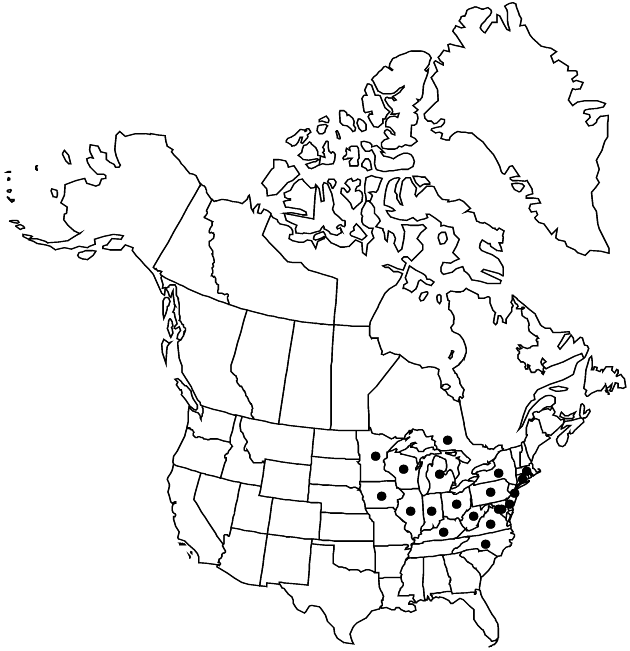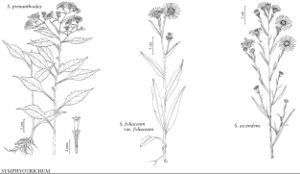Difference between revisions of "Symphyotrichum prenanthoides"
Phytologia 77: 290. 1995.
FNA>Volume Importer |
imported>Volume Importer |
||
| (3 intermediate revisions by 2 users not shown) | |||
| Line 8: | Line 8: | ||
}} | }} | ||
|common_names=Crookedstem aster | |common_names=Crookedstem aster | ||
| + | |special_status={{Treatment/ID/Special_status | ||
| + | |code=F | ||
| + | |label=Illustrated | ||
| + | }}{{Treatment/ID/Special_status | ||
| + | |code=E | ||
| + | |label=Endemic | ||
| + | }} | ||
|basionyms={{Treatment/ID/Basionym | |basionyms={{Treatment/ID/Basionym | ||
|name=Aster prenanthoides | |name=Aster prenanthoides | ||
|authority=Muhlenberg ex Willdenow | |authority=Muhlenberg ex Willdenow | ||
| + | |rank=species | ||
|publication_title=Sp. Pl. | |publication_title=Sp. Pl. | ||
|publication_place=3: 2046. 1803 | |publication_place=3: 2046. 1803 | ||
| Line 38: | Line 46: | ||
-->{{#Taxon: | -->{{#Taxon: | ||
name=Symphyotrichum prenanthoides | name=Symphyotrichum prenanthoides | ||
| − | |||
|authority=(Muhlenberg ex Willdenow) G. L. Nesom | |authority=(Muhlenberg ex Willdenow) G. L. Nesom | ||
|rank=species | |rank=species | ||
| Line 52: | Line 59: | ||
|publication title=Phytologia | |publication title=Phytologia | ||
|publication year=1995 | |publication year=1995 | ||
| − | |special status= | + | |special status=Illustrated;Endemic |
| − | |source xml=https:// | + | |source xml=https://bitbucket.org/aafc-mbb/fna-data-curation/src/2e0870ddd59836b60bcf96646a41e87ea5a5943a/coarse_grained_fna_xml/V19-20-21/V20_1171.xml |
|tribe=Asteraceae tribe Astereae | |tribe=Asteraceae tribe Astereae | ||
|genus=Symphyotrichum | |genus=Symphyotrichum | ||
Latest revision as of 19:59, 5 November 2020
Perennials, 20–90(–120) cm, colonial; long-rhizomatous. Stems 1(–3+), ascending to erect (usually flexuous, sometimes ± straight, sometimes stout, older often dark purple), glabrous proximally, moderately hirsute distally. Leaves thin, margins scabrous, apices mucronate, abaxial faces glabrous, midveins hispid to glabrate, adaxial scabrous; basal withering by flowering, petiolate (petioles slender or slightly winged, bases reddish, dilated, sheathing, ciliate), blades obovate to oblanceolate, 15–70 × 10–20 mm, bases attenuate, margins crenate-serrate, apices acute to obtuse; proximalmost cauline withering by flowering, proximal mostly persistent, petiolate to subpetiolate (petioles ± widely winged, bases dilated, strongly auriculate-clasping), blades ovate to lance-ovate or elliptic-lanceolate to oblanceolate, 80–160(–200) × 15–55 mm, progressively reduced distally, bases attenuate, margins sharply serrate (teeth mucronulate), apices acuminate to subcaudate; distal subpetiolate or sessile (petioles broadly winged, auriculate-clasping), blades oblanceolate to lanceolate, sometimes panduriform, 7–90 × 2–25 mm, progressively reduced distally, more sharply so on branches, bases attenuate (petiolate) or ± cuneate to auriculate-clasping and slightly constricted above auricles (panduriform), margins serrate or entire. Heads in broad, ± flat, corymbo-paniculiform arrays, branches often purplish, divaricate to ascending, slender. Peduncles (8–)10–40 mm, sparsely to densely hispid, bracts lanceolate to linear-lanceolate, 3–12 mm, somewhat grading into phyllaries. Involucres campanulate, 5–6 mm. Phyllaries in 4–6 series, oblong-lanceolate or -oblanceolate, slightly constricted near middle (outer) to linear-lanceolate or linear (inner), ± unequal (flexible), bases indurate 1/5–1/2, margins ± narrowly hyaline, scarious, erose, sometimes ciliolate distally, green zones lanceolate to linear-lanceolate (inner), often distally foliaceous, sometimes outer ± entirely so, apices spreading to ± squarrose, acute to acuminate, mucronulate, abaxial faces sparsely hirsutulous to glabrate or glabrous, adaxial glabrous or sparsely hirsutulous. Ray florets 17–25(–30); corollas usually lavender to blue, rarely white, laminae 7.5–12(–15) × 1–2 mm. Disc florets 39–50(–65); corollas cream colored or light yellow becoming purple or brown, 3.5–5 mm, tubes ± equaling campanulate to funnelform throats (thinly puberulent), lobes triangular, 0.5–1 mm. Cypselae dull purple or stramineous with purple streaks or purplish-tinged, cylindro-oblanceoloid to obovoid, ± compressed, 2–3(–3.5) mm, 4–6-nerved, faces sparsely to moderately strigillose; pappi sordid, 3.5–4.5 mm. 2n = 32.
Phenology: Flowering Aug–Oct.
Habitat: Moist or swampy grounds, woods, thickets, meadows, seeps, stream banks, roadsides
Elevation: 100–1500 m
Distribution

Ont., Conn., Del., D.C., Ill., Ind., Iowa, Ky., Md., Mass., Mich., Minn., N.J., N.Y., N.C., Ohio, Pa., Va., W.Va., Wis.
Discussion
Symphyotrichum prenanthoides is of conservation concern in Canada and in a number of states.
Selected References
None.
